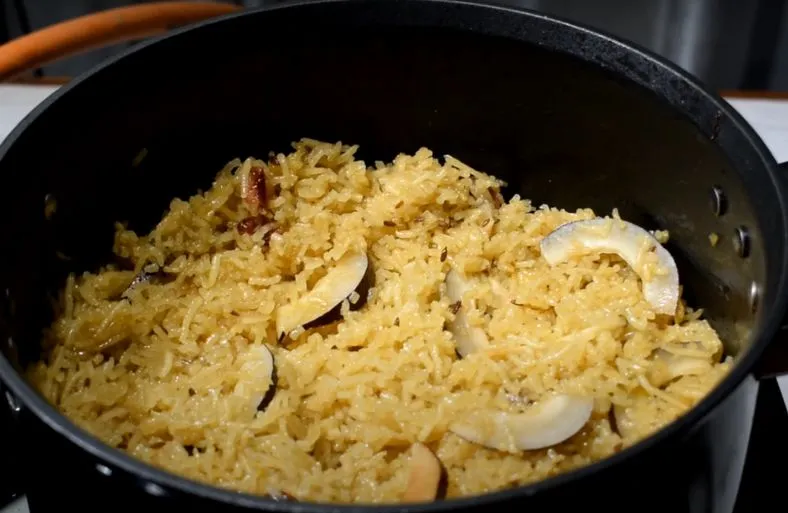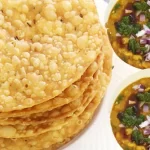What is Sindhi Tahiri
Sindhi Tahiri is a traditional recipe that has been passed down through generations in the Sindhi community. This delightful sweet rice dish is known for its rich flavors, vibrant colors, and aromatic spices. Let’s take you on a journey through the history and preparation of Sindhi Tahiri. Get ready to tantalize your taste buds and learn how to recreate this classic dish in your own kitchen.
The History Behind Sindhi Tahiri
The Sindhi culture of India is where Sindhi Tahiri originated. It is thought to have its roots in Sindh, an area that is now a part of Pakistan. Traditionally, this dish was made for special occasions and family get-togethers, bringing people together to enjoy its excellent flavors.
This Sindhi Tahiri is traditionally served with Sindhi Sai Bhaji.
Cooking & Serving
Preparation Time:
15 mins
Cooking Time:
30 mins
Serves:
4 People
Key Ingredients of Sindhi Tahiri
- Sindhi Tahiri Rice:
- Basmati rice: 1 cup
- Water: 2 cups
- Suga/Jagaryr: 1/2 cup
- Ghee (clarified butter): 2 tablespoons
- Saffron strands: a pinch (dissolved in 2 tablespoons of warm milk)
- Cardamom powder: 1/2 teaspoon
- Cashews: 1/4 cup, chopped
- Almonds: 1/4 cup, slivered
- Raisins: 2 tablespoons
- Pistachios: 2 tablespoons, chopped
- Rose water: 1 teaspoon (optional)
- Edible silver leaf (varq): for garnishing (optional)
Recipe: Step-by-Step Preparation
- Step 1: Soak the Rice
- Basmati rice should be carefully washed before soaking for 30 minutes. When the grains are cooked, this helps to produce fluffy, distinct grains.
- Step 2: Cooking the Rice
- Boil water in a large pot.
- Drain the soaked rice and add it to the boiling water.
- Cook the rice until it is 70-80% done. It should still have a slight bite to it. Drain the rice and set it aside.
- Step 3: Preparing the Sweet Mixture
- Heat ghee over medium heat in a separate saucepan.
- Add the chopped cashews and slivered almonds. Sauté until they turn golden brown.
- Add the raisins and pistachios. Sauté for a minute.
- Pour in the water and bring it to a gentle simmer.
- Stir in the sugar/jaggery, cardamom powder, and dissolved saffron water. Mix well until the sugar is dissolved.
- Let the sweet mixture simmer for a few minutes until the flavors are infused.
- Step 4: Combine the Rice and Sweet Mixture
- Gently fold the partially cooked rice into the sweet mixture.
- Now cover the saucepan and let it simmer on low heat for about 10-15 minutes.
- This will let the rice to absorb the flavors of the sweet mixture.
- Step 5: Final Touches
- Now, remove the saucepan from heat and let the Sindhi Tahiri Sweet Rice rest for a few minutes.
- If required, stir in a teaspoon of rose water to add a subtle floral fragrance.
- Garnish the sweet rice with edible silver leaf (varq) for a touch of elegance.
Serving Suggestions
- Sindhi Tahiri Sweet Rice can be enjoyed warm or chilled
- It can be served as a dessert or main course during special occasions, festivals, and celebrations.
- You can also garnish it with additional nuts and a sprinkle of cardamom powder for an extra visual appeal.
- It is ideal as a special meal during special occasions or for lunch or dinner, or even as a special dish during festivals and celebrations.
- This is also a great combination with Sindhi Sai Bhaji.
- Mango adds greatness to this meal.
Tips
- Sindhi Papad must go along with the meal.
- A great combination with Sindhi Tahiri is Sindhi Sai Bhaji which is very common in Sindhi homes.
- And do not forget to have home salad and prepared pickle.
- Avoid black pepper.
Nutritional Benefits of Sindhi Tahiri
- Carbohydrates: Rice, the main component of Sindhi Tahiri, has good amount of carbohydrates.
- Sindhi Tahiri has moderate quantity of proteins; however, dry fruits add extra nutrients.
- With the goodness of dried fruits and nuts like cashews, almonds, raisins, and pistachios, Sindhi Tahiri Sweet Rice is enhanced. These components give the dish a delicious texture and offer a number of health advantages. They are loaded with vital elements like fibre, vitamins, minerals, and healthy fats.
- Low Fat Content: When made with less oil or ghee, bhugal chawal can be quite low in fat. This makes it a good option for people who want to limit their fat intake.
FAQs (Frequently Asked Questions)
- Can I use brown rice instead of basmati rice for Sindhi Tahiri?
- While basmati rice is traditionally used for Sindhi Tahiri, you can experiment with brown rice for a healthier twist. Adjust the cooking time and water accordingly.
- Is Sindhi Tahiri a vegan-friendly dish?
- Sindhi Tahiri can be made vegan by substituting oil for ghee. Ensure that all the ingredients used are vegan-friendly.
- How long can I store leftover Sindhi Tahiri?
- Leftover Sindhi Tahiri can be stored in an airtight container in the refrigerator for up to 2-3 days. Reheat before serving.





